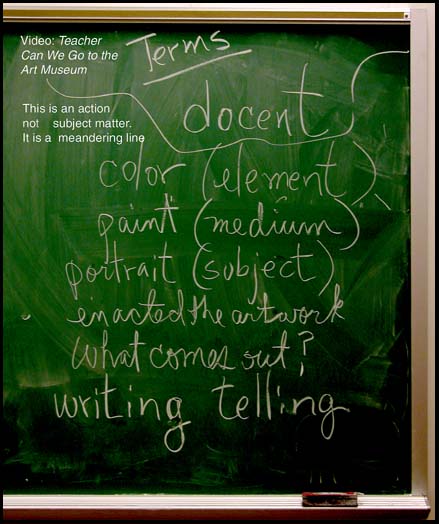whiteboard notes
Goshen College students
may print this page
|
This is a digital camera image from class on
10-7-02 meeting in Music Center 110 after visit to Art Gallery.
Please review all the notes
below
from
our discussion.
|

The Handouts included Art Gallery Visit and Talking
About Art (two sides of one paper).
The chalkboard represents a few of the
concepts related to the video "Teacher Can We Go to the Art Museum.
Our discussion asked for responses to, "What were the strengths of what
was done in this video, and what are some possible alternatives to what
was done." The following is a summary of the discussion for your
notes.
|
Strengths
Behavior reflected good orientation and preparation prior to the visit.
The docent involved them physically by having them enact the actions
of the paintings. Other terms for this method are "role-playing"
and "psychodrama".
Parents related stories about how the visits had increased their interest
in art.
|
Alternatives
Orientation prior to visit could include preliminary study of artworks
that they are apt to see in the museum.
More could have been learned about the role of portraits (pictures of
people) in our lives. More could have been learned about the differences
between original and reproductions of art and of people.
Instead of having them paint what they had learned in the museum, they
could write and talk about what they had seen.
Instead of having them paint what they had learned in the museum,
they could have painted some picture BEFORE going to the museum that would
be based on their own experiences that are similar to experiences that
the artists are representing in the museum.
They could have made self portrait pictures, or if still in scribbling
stage, they could have studies photographs of themselves prior to the visit.
They could have painted very "controlled" and very "wild" scribble based
paintings using role-playing as motivation without having seen museum examples.
This would bring another frame of reference for appreciation of the museum
artwork. This would not have a chance of "copying" or imitating the
"look" of another artist's creativity.
|
In a related discussion we covered questions
about class projects, holidays projects, and coloring books. These
are a few questions we can ask ourselves in order to decide if an art activity
deserves to take school time or not.
-
Does it teach "thinking" or mainly does it
give instruction for "doing"?
-
Does the child learn a process of working
or is the emphasis mainly on the look of the end product? -- a product
example is red flower on green stem -- a process example is using
a sighting aide to draw an actual flower from observation.
-
Does the lesson tend to teach us to be independent
learners or does it tend to teach us to be good slaves who make things
well according to instructions?
There are parts of some school subjects that are appropriately
learned by the process of
imitation
.
However, art projects and activities are particularly well suited to provide
a chance to teach
innovative thinking
processes and to practice creative and original thinking that expresses
their own lives effectively.
Children love to color pictures, so we encourage them
to color their own drawings. Children love to decorate the classroom,
so we encourage them to create colorful original work that reflects their
own responses to their lives and ideas. We give them topics they
care about. Children need to own the ideas and the work. As
teachers we are not clerks who merely pass out patterns and materials.
We understand the questions that can be meaningful to children. We
give assignments that deal with these questions. We understand that
children have a basic need to express
themselves
(not reproduce and adult's visual answer).
We know how to help children attain expertise with skills.
We help them practice their skills. We understand how this skill
helps their self-esteem. We have them practice things like observation
drawing, like shading from observation, like gesture drawing for more expression,
etc. They become as comfortable with drawing and modeling in the
same way they become comfortable with speaking, dancing, singing, and writing
- with practice. Instructed practice helps if it is done in way that
honors and repects the child more than the look of the work.
All of this is so important that we refrain from wasting
classtime on "busywork" activities. If we do a busywork project to
decorate the room for a holiday, it confusses the children. They
begin to think that those things are actually art. Even many teachers
school adminstrators seem to think that these step-by-step products are
art. This class is
Art
for Children.
It is not Projects that Children Can Do. We can get those from pattern
books, the internet, and many other places. That would not be content
worthy of a college level course.
Goshen students and others are invited to respond to this.
What are your questions? What are your creative ideas about better
teaching?
Goshen
College students may print this page for their own use.
|
